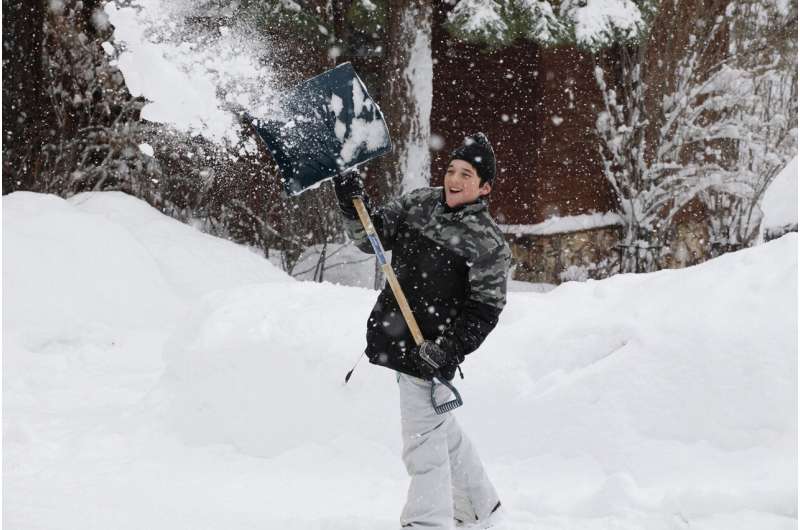This article has been reviewed according to Science X's editorial process and policies. Editors have highlighted the following attributes while ensuring the content's credibility:
fact-checked
trusted source
proofread
Snow shoveling, cold temperatures combine for perfect storm of heart health hazards

Weather forecasters may call it "white fluffy stuff." However, snow can be a bigger danger than many people may realize. According to the American Heart Association, research shows that the exertion of shoveling snow may lead to an increased risk of a heart attack or sudden cardiac arrest.
The American Heart Association's 2020 scientific statement, "Exercise-Related Acute Cardiovascular Events and Potential Deleterious Adaptations Following Long-Term Exercise Training: Placing the Risks Into Perspective–An Update," notes snow shoveling among the physical activities that may place extra stress on the heart, especially among people who aren't used to regular exercise. Numerous scientific research studies over the years have identified the dangers of shoveling snow for people with and without known heart disease.
The lead author of that scientific statement and long-time American Heart Association volunteer Barry Franklin, Ph.D., FAHA, is one of the leading experts on the science behind the cardiovascular risks of snow shoveling. He has authored a number of studies on the topic, estimating that hundreds of people die during or just after snow removal in the U.S. each year.
"Shoveling a little snow off your sidewalk may not seem like hard work. However, the strain of heavy snow shoveling may be as or even more demanding on the heart than taking a treadmill stress test, according to research we've conducted," said Franklin, who is director of preventive cardiology and cardiac rehabilitation at Corewell Health East, William Beaumont University Hospital and a professor of internal medicine at Oakland University William Beaumont School of Medicine in Royal Oak, Michigan.
"For example, after only two minutes of snow shoveling, study participants' heart rates exceeded 85% of maximal heart rate, which is a level more commonly expected during intense aerobic exercise testing. The impact is hardest on those people who are least fit."
Franklin noted five key ways snow shoveling affects heart health:
- Snow shoveling involves mostly Isometric or static exertion that involves the contraction of muscles without any movement in the surrounding joints.
- The act of shoveling snow is mostly arm work, which is more taxing and demanding on the heart than leg work.
- While straining to lift heavy loads, such a shovelful of snow, you often unconsciously hold your breath, which causes big increases in heart rate and blood pressure.
- Since you are mostly standing still while shoveling, your legs are not moving much which results in pooling of blood in the lower extremities, so it is not getting back to the heart which needs the oxygenated blood.
- Breathing/exposure to cold air causes constriction of blood vessels throughout the body, disproportionately raising blood pressure and simultaneously constricting the coronary arteries (which are about the size of cooked spaghetti).
"The movements of snow shoveling are very taxing and demanding on your body and can cause significant increases in your heart rate and blood pressure," Franklin said. "Combined with the fact that the exposure to cold air can constrict blood vessels throughout the body, you're asking your heart to do a lot more work in conditions that are diminishing the heart's ability to function at its best.
Franklin cautioned the impact of snow removal is especially concerning for people who already have cardiovascular risks like a sedentary lifestyle or obesity, being a current or former smoker, having diabetes, high cholesterol or high blood pressure, as well as people who have had a heart attack or stroke.
"People with these characteristics and those who have had bypass surgery or coronary angioplasty simply should not be shoveling snow in any conditions," he said. "We often see events in people who are usually sedentary, they work at a computer all day or get little or no exercise. Then once or twice a year they go out and try to shovel the driveway after a heavy snowfall and that unexpected exertion can unfortunately lead to tragedy."
Franklin recommends the following tips to reduce increased risk from snow shoveling:
- If you have known or suspected heart disease or risk factors for heart disease, get someone else to do your snow removal for you.
- If you must shovel the snow, start gradually and pace yourself. Always cover your mouth and nose, wear layered clothing, as well as a hat and gloves.
- Ideally, push or sweep the snow rather than lifting and throwing it, that action involves a little less exertion.
- Be extra careful when the wind is blowing; the wind makes the temperature feel even colder than it is and will increase the effects of the cold on your body.
- Use an automated snow blower rather than shoveling. While you should still proceed with caution and be mindful of how your body is feeling, research shows that using a snow blower raises the heart rate to around 120, compared to a heart rate of around 170 experienced while shoveling.
The American Heart Association urges everyone to learn the common signs of a heart attack and stroke. If you experience chest pain or pressure, lightheadedness or heart palpitations or irregular heart rhythms, stop the activity immediately. Call 9-1-1 if symptoms don't subside shortly after you stop shoveling or snow blowing. If you see someone collapse while shoveling snow, call for help and start Hands-Only CPR if they are unresponsive with no pulse.
More information: Learn more about cold weather and cardiovascular disease here.


















